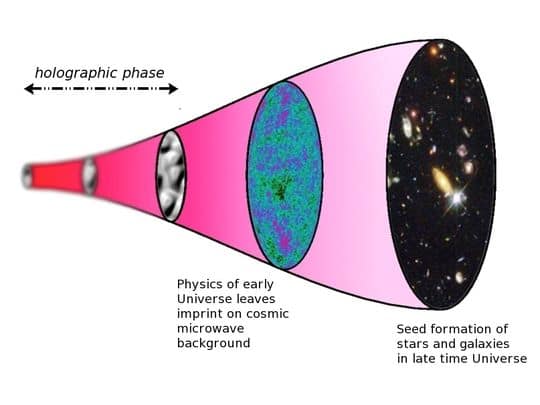Mind blown: The entire universe could be a hologram
A new study released Monday, Jan. 30, 2017 suggests that the universe could be a hologram, and reality could be an illusion. Wochit
Talk about a reality check: The entire universe could be a “vast and complex hologram,” scientists reported Monday. Also, even more unsettling, what we think of as reality may be just an illusion.
“Imagine that everything you see, feel and hear in three dimensions (and your perception of time) in fact emanates from a flat two-dimensional field,” said study co-author Kostas Skenderis of the U.K.’s University of Southampton.
“The idea is similar to that of ordinary holograms where a three-dimensional image is encoded in a two-dimensional surface, such as in the hologram on a credit card,” Skenderis said. “However, this time, the entire universe is encoded.”

A sketch of the timeline of the holographic universe. Time runs from left to right. The far left denotes the holographic phase and the image is blurry because space and time are not yet well defined. At the end of this phase (denoted by the black fluctuating ellipse) the universe enters a geometric phase, which can now be described by Einstein’s equations. The cosmic microwave background was emitted about 375,000 years later. Patterns imprinted in it carry information about the very early universe and seed the development of structures of stars and galaxies in the late time universe (far right). (Photo: Paul McFadden)
It’s similar to watching a 3-D movie in a cinema, according to the study. While we see the pictures as having height, width and depth, they in fact all originate from a flat two-dimensional screen.
The study authors say they found the evidence for a holographic universe by studying the “afterglow” of the Big Bang with powerful new telescopes.
The telescopes detected a vast amount of data hidden in the “white noise” or microwaves left over from the moment the universe was created. Theoretical physicists and astrophysicists first identified the concept of a holographic universe in the 1990s, and this discovery is the best evidence yet for that theory.
The odd theory is equally likely to other, more traditional hypotheses about what makes up the universe, the scientists say, adding that it may further explain Einstein’s theory of gravity and also quantum theory.
The study appeared in the journal Physical Review Letters[1] and was led by scientists from Canada, England and the U.S.
References
- ^ Physical Review Letters (journals.aps.org)
- ^ 1 of 24 (rssfeeds.usatoday.com)
- ^ 2 of 24 (rssfeeds.usatoday.com)
- ^ 3 of 24 (rssfeeds.usatoday.com)
- ^ 4 of 24 (rssfeeds.usatoday.com)
- ^ 5 of 24 (rssfeeds.usatoday.com)
- ^ 6 of 24 (rssfeeds.usatoday.com)
- ^ 7 of 24 (rssfeeds.usatoday.com)
- ^ 8 of 24 (rssfeeds.usatoday.com)
- ^ 9 of 24 (rssfeeds.usatoday.com)
- ^ 10 of 24 (rssfeeds.usatoday.com)
- ^ 11 of 24 (rssfeeds.usatoday.com)
- ^ 12 of 24 (rssfeeds.usatoday.com)
- ^ 13 of 24 (rssfeeds.usatoday.com)
- ^ 14 of 24 (rssfeeds.usatoday.com)
- ^ 15 of 24 (rssfeeds.usatoday.com)
- ^ 16 of 24 (rssfeeds.usatoday.com)
- ^ 17 of 24 (rssfeeds.usatoday.com)
- ^ 18 of 24 (rssfeeds.usatoday.com)
- ^ 19 of 24 (rssfeeds.usatoday.com)
- ^ 20 of 24 (rssfeeds.usatoday.com)
- ^ 21 of 24 (rssfeeds.usatoday.com)
- ^ 22 of 24 (rssfeeds.usatoday.com)
- ^ 23 of 24 (rssfeeds.usatoday.com)
- ^ 24 of 24 (rssfeeds.usatoday.com)























